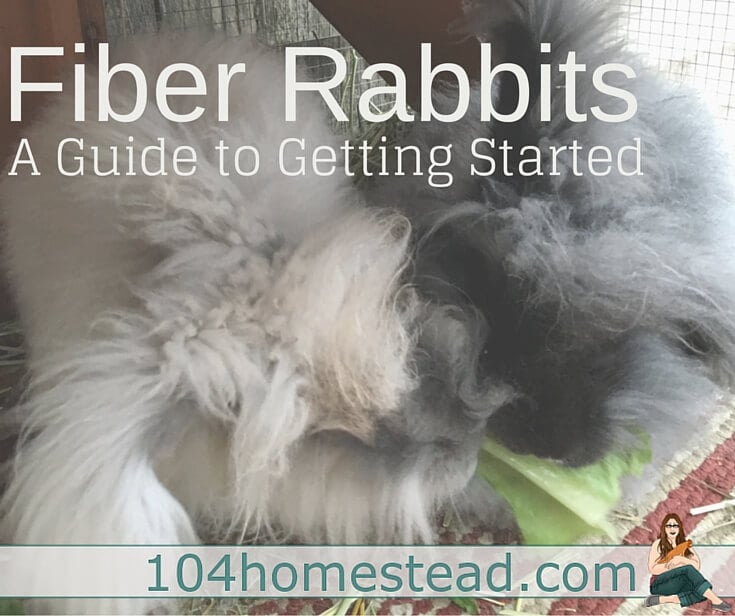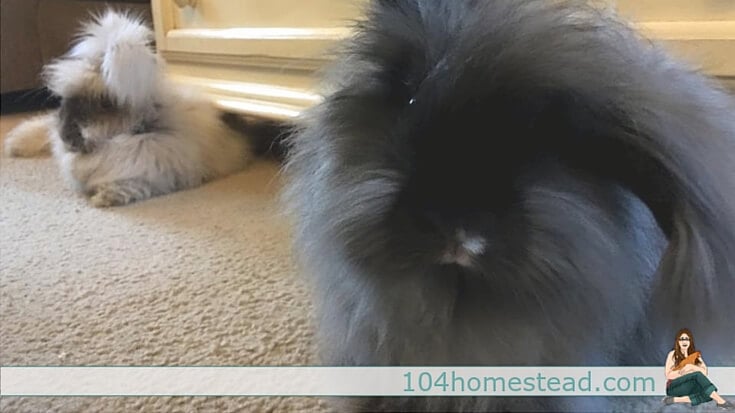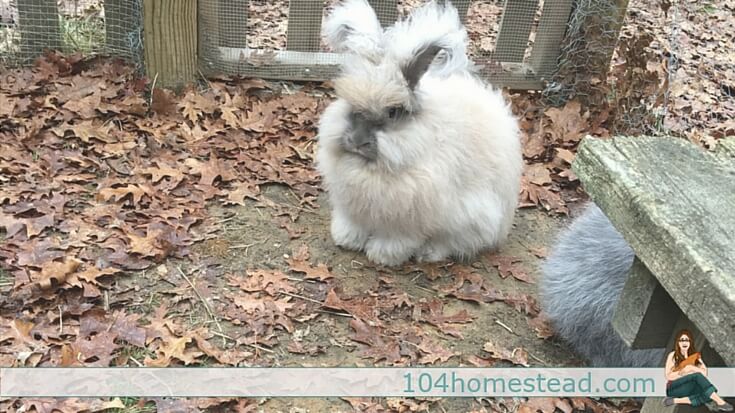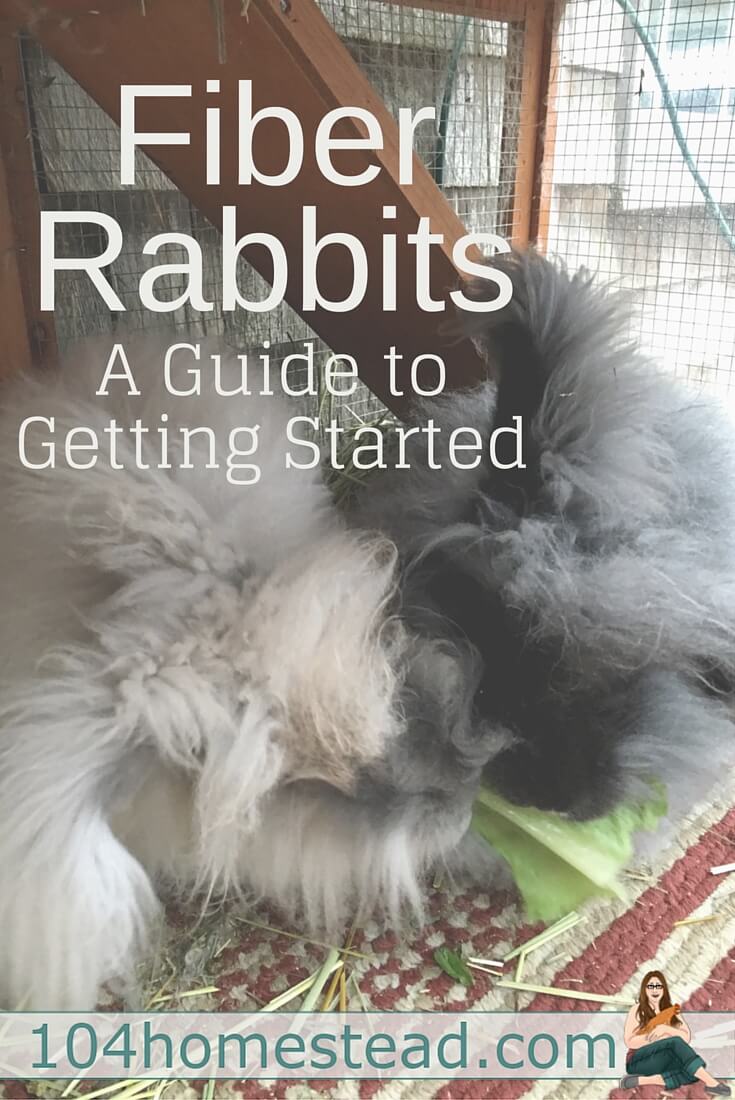Raising Fiber Rabbits – What You Need to Know
Are you getting ready to add fiber rabbits to your farm? Rabbits are the perfect choice for someone who wants to start producing their very own fibers for personal use or profit.

Are you getting ready to add fiber rabbits to your backyard farm? Congratulations!
Rabbits are the perfect choice for backyard farmers that would like to start producing their own fibers for either resale or crafts. Typical fiber farm animals include sheep, goats, or alpacas – some of which can top out at 200 pounds or more – not always practical for someone farming on under an acre of land. Rabbits need minimal space and don’t require special farm vets, almost all suburban vets will have experience treating rabbits. In addition to less land and less feed, rabbits are wooly powerhouses!
There are several breeds of Angora rabbits that are typically raised for their silky soft angora fibers. The biggest is the Giant Angora weighing in around 10-12 pounds when fully grown, they can produce up to 2.5 pounds of wool a year (about 25% of their weight!). Compare that to the average sheep harvest which only yields about 6-8% of her body weight per year and you can see rabbits pack a big bang in a small package. Click here to learn more about the different breeds of angora rabbits.
Basic Fiber Rabbit Care
Feeding
Just like all animals on your homestead, having access to fresh water & feed is important for optimal health. Fiber rabbits in particular need to be fed a high-quality diet, rich in fiber & protein. The fiber will keep their digestive system moving so they do not succumb to wool block. Wool block can occur when the rabbit ingests too much of their own fur during grooming. If the wool gets gummed up in their digestive tract it causes a blockage which can lead to a painful death. Fresh Timothy hay should always be available for rabbits to eat free choice.
In addition to the hay, fresh vegetables should be offered daily. Aim for 1-2 cups of fresh vegetables per day, per rabbit. Popular choices include dark leafy greens like romaine lettuce or spinach, dandelion greens & clovers, and root vegetable tops. High in natural sugar, carrots, and fruit should be reserved for an occasional treat.

Protein is also important for supporting continual wool production. Look for rabbit pellets with about 18% protein, often marketed as pro or high performance you might have a hard time finding this at your local pet store (most commercial brands are only 14-16%). Feed stores will typically offer a better selection of high-quality rabbit pellets. Given the choice, your rabbit will fill up on pellets and ignore the hay & vegetables, so offer only about 1/2 – 3/4 cup of pellets per rabbit daily.
I have a complete list of what to feed rabbits you might want to take a look at.
Housing
Rabbits can happily be kept inside or outside. In either location, you will want to provide them with a secure hutch or cage that is at least 6 feet long x 2 feet wide x 2 feet tall. In addition to their hutch or cage, they will need a secure exercise area of about 35 square feet per rabbit and at least 2 feet tall. Rabbits love to jump, run and explore, giving them room to roam will keep them happy and keep them from getting bored. A bored bunny will pick on playmates or practice destructive chewing (on either themselves or their surroundings). To check out my rabbit setup, click here!
Rabbits are very social creatures and need companionship. If you are keeping your rabbit inside and can spend lots of time with her, you can be that companion. If your rabbit will live outside or you are away at work most of the day, you should plan on getting at least a pair of rabbits (same-sex or spayed/neutered unless you want A LOT of rabbits!).

For outdoor rabbits, predator protection will be high on your priority list. Raising your hutch off the ground and securing the exercise area complete with sturdy hardware cloth is necessary. Outside, you also need to contend with the elements. With all the fur, Angoras are fine outside even with temperatures approaching zero as long as you keep them out of the wind. Summer heat can be harder on them and if your outdoor temperatures are regularly over 80 degrees, keeping these bunnies outside could be challenging. For indoor rabbits, you still need to provide protection from household hazards. Be sure they can’t access cleaning supplies. They also love to chew on electric wires, furniture legs, and woodwork or dig through upholstered furniture. Those cute little bunnies can be very destructive, be sure their area is properly rabbit-proofed.
Daily cleaning of their cage will be important. Not only will it keep them healthy, but you also don’t want their fiber to be crusted with feces or soaked in urine.
Grooming
One of the most time-consuming chores of owning fiber rabbits will certainly be grooming. Weekly grooming will be necessary, and during molting periods you may find it needs to be done 3-4 times per week. For this reason, you need to be comfortable handling your rabbits, and they need to be accustomed to handling them.
Ideally, fiber rabbits will begin getting used to regular grooming and handling at a very young age. Kits can leave their mother between 6-8 weeks of life and you should get them used to regular handling at this point. When purchasing your fiber rabbits, ideally you will get them at a very young age so you can ensure proper socialization. If you purchase adolescent or adult rabbits be sure it is from a reputable breeder who has been handling the rabbit regularly. Ask her to demonstrate grooming to see how the rabbit reacts. Trust me, you don’t want to deal with a rabbit that is biting, scratching, and wiggling away during grooming. Your rabbits should enjoy grooming and it can be a very relaxing and enjoyable chore for you as well.
I usually bring my outdoor rabbits inside for weekly grooming. I sit with them on my lap or in front of me while I sit on the floor. I can groom them while watching TV or hanging out with my kids and it takes about 30-40 minutes per rabbit. For a more in-depth grooming tutorial, click here.
Harvesting Fiber from Your Rabbits
Angora rabbits are constantly releasing fur and growing new fur so every grooming session will yield some wool. 3-4 times per year the rabbits will molt and HUGE amounts of fur are released. There are three main methods for removing the wool from your rabbit.
First, you have plucking, which is not nearly as horrible as it sounds. This is the method (albeit done incorrectly) of the unscrupulous Chinese angora farmers featured in the painful PETA video where the rabbits are left screaming and bloody. MOST angora farmers do not subject their animals to this torture, “plucking” a rabbit is running your fingers through their fur and gently removing the loose tendrils, basically using your fingers as a comb. You are NOT pulling the fur out from the skin like in the video, only removing the fur that has already been released from the skin.

The next method is shearing, where you would use clippers or scissors to remove the fur. Usually done during molting periods, this method is the fastest, but the downside is when you cut the fur, you get fur in all different lengths and stages of growth. Shorter fur is not ideal for spinning as it can be shed out of the yarn.
The method I use is combing, where you brush out the loose fur that has already been released. The fur will naturally release when it is around 4-5 inches (in most breeds) in length and this is the perfect length for spinning & crafting, your job is just to comb the loose fur out.


It’s good to know that fiber rabbits need to be groomed regularly to keep their fur growing in good condition. My wife and I are interested in raising fiber rabbits as a side hobby, and we’d like to know what expenses go into it before we get started. We’ll be sure to look into our options for professional groomers for them in the future.
How many bunnies do you have in the coop? So precious!
How do you find a buyer for the fiber?
I’m sure Liz can chime in with more, but a lot of people I know sell their fiber through farmer’s markets as well as on Etsy.
There are lots of people that buy & sell Angora fiber on Etsy. I have seen it listed on there raw (not processed at all, just brushed from the bunny) for anywhere from $4-$10+ an ounce depending on the quality & color. If you get into processing the fiber by either making it into rolags for spinning or dying it the price can go up from there. Other than Etsy, local farmer’s markets or craft fairs are excellent places to start to find loyal buyers